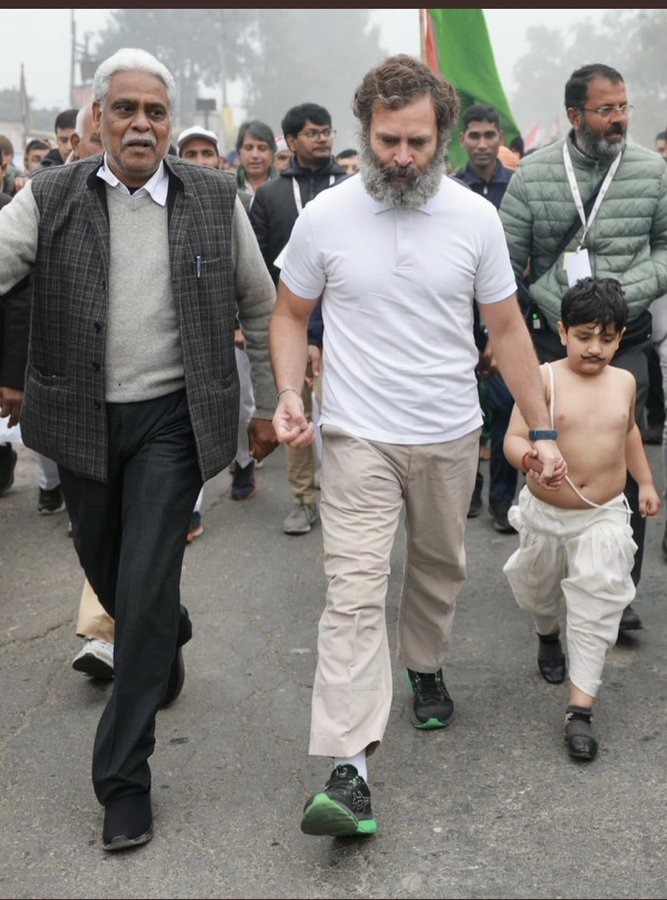Bharat Jodo Yatra discourse provides bizarre ‘insight’ on India’s past, sans a map for its future.
Rahul Gandhi’s Bharat Jodo Yatra is now on its penultimate lap, traversing through Punjab—in a fortnight’s time it should reach its destination, Srinagar in Jammu & Kashmir. Going by the bizarre insights on India’s past enunciated by the former president and present principal patron of the Grand Old Party, let us keep our fingers crossed: he may disclose some rare aspect of the history of Kashmir (unheard of so long) or throw some new “light” on the accession of the territory to the Indian Union. (He is clearly in the Gupkar Alliance camp, as Farooq Abdullah has walked alongside him on the outskirts of Delhi and Mehbooba Mufti is expected to be by his side when he is in the vale.) I write this in the light of the decrees on Mahabharat which emanated while he was traversing Haryana, where Kurukshetra is located. According to RahulG, the Pandavas were tapaswis (ascetics); they were five in number and in the Mahabharat war they were up against the Sangathan (organisation) of the Kauravs (a reflection that an organisationally truncated Congress faces the formidable Sangh Parivar?); they were backed by people from all religions; and they never imposed GST or promulgated demonetisation. A rare insight indeed—he may like to elaborate how many religions were in vogue in India during the Mahabharat period. Also, while ancient India having democratic institutions is recorded history, so far no scholar has fathomed that a tax like GST existed in those venerable times and that demonetisation as a concept had evolved. With his ruffled beard (his image makers, the outsourced Bombay based start-up called Teen Bandar, perhaps have advised that the beard gives the look of a man in anguish, whose commitment and urgency to his cause does not even give him time to trim) RahulG, sporting a tilak when he visits Hindu shrines and a turban while paying obeisance at a Gurudwara, projects himself as a tapaswi. He asked his audiences why BJP and Sangh leaders never say Har-har-Mahadev or Jai Siya Ram—omitting Sita. (The tertiary Sangh media team immediately posted on social sites Narendra Modi’s speeches in Varanasi during the opening of the Kashi corridor and at the foundation laying of the temple in Ayodhya, where the Prime Minister repeatedly led the crowd in raising the slogans cited by RahulG.) According to him, Shiv is a tapaswi and the followers of Sangh apparently are pujaris (worshippers, a moniker for “bhakt”?) and thus they do not chant Har Har Mahadev or refer to Sita while worshipping Ram. His jibe at pujaris triggered angry retort from a section of the priests of the shrines he was visiting.
RahulG’s attempt at projecting himself as a “Janeu-dhari Hindu” (one who wears the sacred thread) in 2017 had come a cropper. This however did not deter the Yatra organisers from putting a dhoti-clad bare-chested young lad sporting a janeu in the front row of the show when RahulG was entering Haryana. The janeu was worn on the right shoulder (which is the practice during inauspicious occasions like a shradh) and not on the left shoulder, which is auspicious. The picture of the bare chested young lad holding the hand of RahulG on a chilly morning was duly posted on the Twitter handle of the Congress party—and summarily withdrawn soon afterwards as some Twitter users pointed out that sacred thread worn on left shoulder (upaviti) is auspicious while worn from the right (prachnaviti) was inauspicious. Thus the “Janueu-dhari” attempt bombed yet again.
There was another faux pas in the post-Christmas-break
The Yatra management is being overseen by AICC general secretary Jairam Ramesh and by Yogendra Yadav, founder of Swaraj India, who represents the interests of the 150-odd NGOs which are backing the endeavour. The Nehru-Gandhi Parivar’s preference for civil society activists is clearly visible. The impact of these NGOs on Congress was recently cited in a TV discussion on the lack of infrastructure on the China border which is now being rectified: Apparently PM Manmohan Singh had flagged the issue and projects were planned in Arunachal Pradesh which were red flagged by environmental NGOs who had the ear of the powers that be. Congress leaders by and large are wary of the civil society elements that were as opposed to Congress regimes as they are to the government of Narendra Modi. The Medha Patkar effect on Congress rout in Gujarat is cited.
Congress has invited 21 parties to participate in the last leg of the Yatra. The near total decimation of the GOP is sought to be bolstered by the association of these parties, many of whom did not respond to the Yatra by fielding their frontline leaders as the show passed through their respective areas of influence. Invites have been denied to Biju Janata Dal, YSRCP, AIADMK, AIMIM, AIUDF, as they are not considered likeminded parties. AAP, Trinamool, KCR’s BRS have been invited—it is to be seen how they react—Akhilesh Yadav’s SP, Mayawati’s BSP and Jayant Choudhari’s RLD, invited again, had skirted the Yatra in their region. CPI(M) has been invited—in fact as the Yatra progresses, an electoral pact between Congress and CPI(M) in Tripura is on anvil, the acerbic rivalry of these parties in Kerala, where CPI(M) rules and Congress is Opposition, notwithstanding.
Rahul Gandhi Yatra’s aim seems to be to achieve Tamilnaduisation of Congress—the party was ousted in the southern state, and then called Madras, in 1967. In the past 55 years it has been in and out of ruling coalitions in Tamil Nadu either as a junior partner of DMK (as at present) or of AIADMK. A similar scenario is perhaps envisaged at the Centre as well. While enunciating bizarre theories on history and mythology the Yatra has not come up with a road map either for a different India or for a resurrected GOP.

